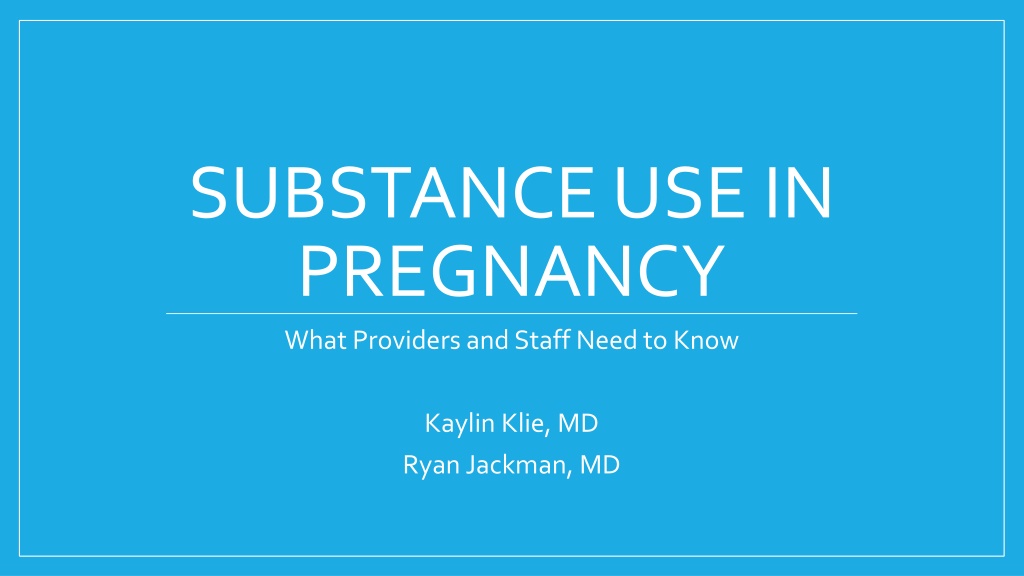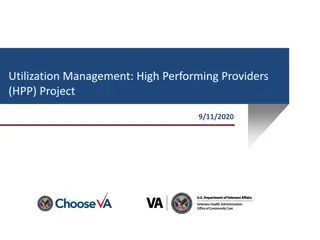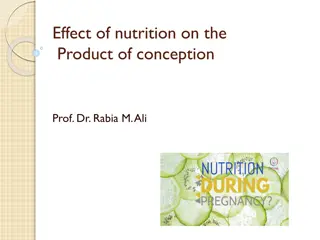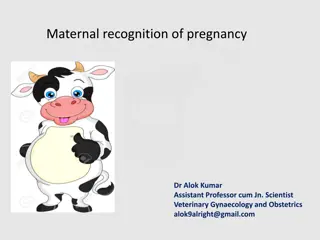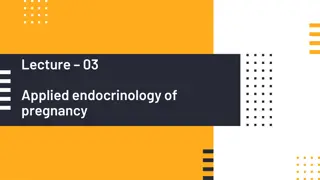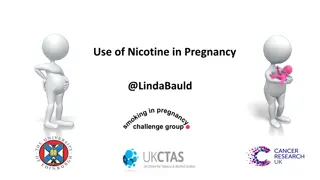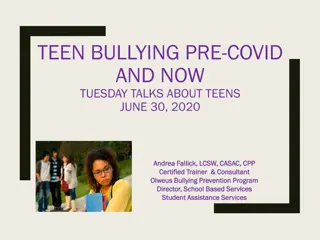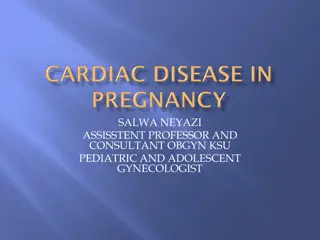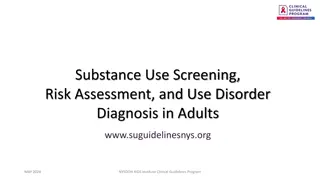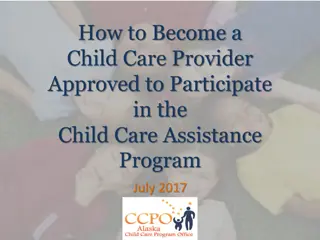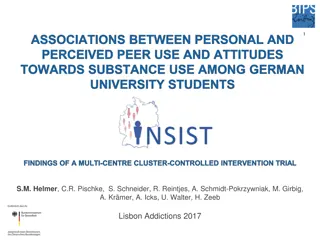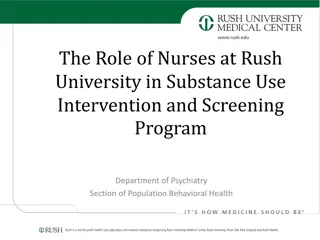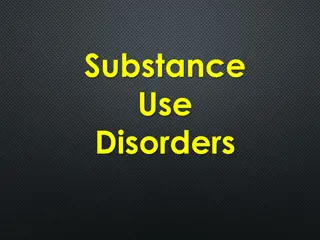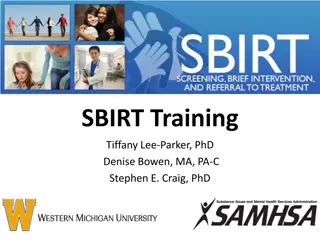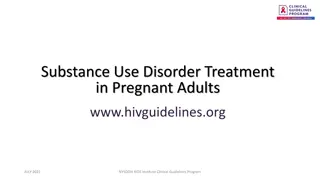Substance Use in Pregnancy: Important Considerations for Healthcare Providers
This presentation discusses the impact of substance use during pregnancy, including identifying signs of substance use disorder, trends in national and Colorado statistics, effects on maternal health and fetal development, screening recommendations, minimizing stigma, and treatment options for pregnant women with substance use disorders. The data highlights the significant challenges and risks associated with substance use in pregnancy, emphasizing the importance of early detection and intervention to ensure the well-being of both mother and child.
Download Presentation

Please find below an Image/Link to download the presentation.
The content on the website is provided AS IS for your information and personal use only. It may not be sold, licensed, or shared on other websites without obtaining consent from the author. Download presentation by click this link. If you encounter any issues during the download, it is possible that the publisher has removed the file from their server.
E N D
Presentation Transcript
SUBSTANCE USE IN PREGNANCY What Providers and Staff Need to Know Kaylin Klie, MD Ryan Jackman, MD
Disclosures We have no financial disclosures that I know of.
Objectives Identify the signs and symptoms of substance use disorder, and be able to use them to differentiate substance use disorder from substance use. Discuss the trends of substance use during pregnancy nationally and in Colorado Describe how substances affect the physiology of a pregnant patient and the fetus Understand the recommendations surrounding screening for substance use in pregnancy, and describe screening tools available Discuss ways in which to minimize stigma and encourage participation in prenatal care among women who use or have used substances in pregnancy List and compare treatment options for substance use disorders, including medication assisted treatment, in pregnancy
Substance use Substance Use Disorder In the past 12 months: Taking in larger amounts/longer period than intended. Unsuccessful efforts to cut down or quit Great deal of time spent in obtaining, using, or recovering Cravings, strong desire Failure to fulfill major obligations because of use Use despite social or interpersonal problems Recurrent use despite physical hazard Use despite insight into physical and psych consequences Tolerance Withdrawal
What are the national statistics? (2020) [1] Substance/quantity Non-Pregnant (15 to 44) Pregnant (15 to 44) Alcohol (any amount) 52.4% 10.6% Alcohol (binge drinking) 26.8% 5% Illicit substances (includes MJ) 17.8% 8.3% The rates of substance use and, therefore, infants exposed to substances is still high with more than 400,000 infants exposed to alcohol or illicit drugs in utero each year. The majority coming in mothers < 25 y/o * Historically alcohol use is lower during the second and third trimesters than during the first trimester
What are Colorados statistics? Per the perinatal substance use data linkage study (SB19-228 and SB 21-137): There has been a 98% increase in newborns exposed to opioids between 2012 and 2018 During this same time, drug overdose was the leading cause of pregnancy-associated death 75% of pregnancy-associated deaths in Colorado were deemed preventable. Among pregnant patients in Colorado enrolled in the Pregnancy Risk Assessment Monitoring System (PRAMS), 2020 report [3]: 15.4 percentreported consuming alcohol in their last trimester. Of those the majority reported drinking 1 drink/week or less. In the past two years 29.2% reported any smoking in their last trimester 6.8% reported using marijuana or hashish at any time during pregnancy
But everyone uses marijuana Kaiser Permanente - CA NIDA. Martin et al 2015
What about Opioids? Nationally, the number of women with opioid- related diagnoses documented at delivery increased by 131% from 2010 to 2017 [4]
Biopsychosocial impacts of substance use Effects on Mother & Pregnancy Substance Exposure Effects on Fetus and the need for integrating care
Depressant effects on pregnancy Also for mother: Respiratory Depression (all) Worsened constipation (opioids) Decreased pain tolerance and increased pain sensitivity (opioids) IV related infections (opioid/benzo) EtOH Benzo Opioid Decreased Fetal Growth Decreased FHR Decreased Variability Fetal Alcohol Spectrum Disorder (EtOH specific) Withdrawal Neonatal Opioid Withdrawl Syndrome
Withdrawal during pregnancy Withdrawal when not identified and treated can be fatal to both mother and fetus
Estimated Prevalence of FASD In this cross-sectional study of 13,146 first-grade children in 4 regions of the United States surveyed between 2010 and 2016, the most conservative prevalence estimate for fetal alcohol spectrum disorders ranged from 11.3 to 50.0 per 1000 children. Using a weighted approach, the estimated prevalence was 31.1 to 98.5 per 1000 children.
Stimulants effects on pregnancy Also for mother: Hypertension Respiratory disease Psychosis (meth and cocaine) Worsens other withdrawal syndromes IV related infections Cocaine Meth SGA or IUGR Increased FHR Pre-eclampsia Placental abruption PROM/PPROM Preterm labor Nicotine Developmental delays (Meth and Cocaine specific) Increased risk for SIDS (tobacco) Withdrawal syndrome Depression
Effects of marijuana on pregnancy Marijuana has been shown to clinically improve: Nausea and vomiting Chronic pain Muscle spasticity Marijuana has been shown to have negative impacts on cognitive development and is associated with preterm labor and low birth weights* There is no safe amount or formulation of MJ in pregnancy. https://www.colorado.gov/pacific/sites/default/files/MJ_RMEP_Pregnancy- Breastfeeding-Clinical-Guidelines.pdf *difficult to separate from tobacco use
Other effects of marijuana Concurrent substance use/misuse (tobacco>alcohol>prescriptions>illicit substances) Decreased prenatal care, out of hospital birth (fear) Intoxication: accidents, paranoia, psychosis, physical illness/toxicity Withdrawal Asthma/pulm dx (96% of marijuana use reported in pregnancy is used via smoking) Increase risk of dysfunctional labor, precipitous labor, and meconium-stained amniotic fluid
Biden-Harris Administration approach to substance use in pregnancy: Need for a different approach 1. Having SUD in pregnancy is not, by itself, child abuse or neglect. 2. Criminalizing SUD in pregnancy is ineffective and harmful as it prevents pregnant women with SUD from seeking and receiving the help they need. Prevalence of Parental Alcohol or Other Drug Use as a Contributing Factor for Reason for Removal in the United States, 2000 to 2015 3. Everyone has the right to effective treatment, and denying such care on the basis of sex or disability is a violation of civil rights. 4. Pregnant women using substances or having SUD, should be encouraged to access support and care systems, and barriers to access should be addressed, mitigated, and eliminated where possible. 5. Improving coordination of public health, criminal justice systems, treatment and early childhood systems can optimize outcomes and reduce disparities. In 2018, 20% of foster care placements were infants [5]
Need to screen Screening for substance use should be part of comprehensive obstetric care and should be done at the first prenatal visit in partnership with the pregnant woman. Screening based only on factors, such as poor adherence to prenatal care or prior adverse pregnancy outcome, can lead to missed cases, and may add to stereotyping and stigma. Therefore it is essential that screening be universal.
Need to screen Only 20% of OB/GYN physicians effectively screen for substance use disorders, and yet pregnancy has been found to be one of the best times to intervene in substance use disorder. Routine screening should rely on validated tools for screening in pregnancy: 4 P s , 4 P s plus, 5 P s NIDA Quick Screen SURP-P
5 Ps Did any of your Parents have problems with alcohol or drug use? Do any of your friends (Peers) have problems with alcohol or drug use? Does your Partner have a problem with alcohol or drug use? Before you were pregnant did you have problems with alcohol or drug use? (Past) In the past month, did you drink beer, wine or liquor, or use other drugs? (Pregnancy) Sensitivity: 87% Specificity 76%. Validated in the inpatient & outpatient settings
NIDA Quick Screen Validated in multiple settings New tool developed from the Quick Screen - TAPS: https://www.drugabuse.gov/taps/#/
Substance Use Risk Profile Pregnancy (SURP-P) Have you ever smoked marijuana? In the month before you knew you were pregnant, how many beers, how much wine, or how much liquor did you drink? Have you ever felt the need to cut down on you drug or alcohol use? Low Risk = No to all, Moderate Risk = Yes to 1, High Risk = Yes to 2 or more Sensitivity: 80-100% (low risk), 48-100% (high risk) Specificity: 61-64% (low risk), 84-86% (high risk) Validated in prenatal clinics
I am screening my patients, now what? Brief Interventions Step by Step: Acknowledge and thank the patient for the disclosure. 1. Ask permission to discuss the result 2. For a negative screen: Reinforce & Educate. Stop here. 3. For a positive screen: Express concern about substance use 4. Advise woman to stop use: I m glad you let me know you ve had some___________ . Would it be okay if we talked about this? Since I know you want a healthy baby, it s important you don t use any ________while pregnant because it can have a harmful impact on your baby. 5. Assess/validate woman s reaction and discuss her feelings & thoughts. 6. Ask: Would you like some help to stop using _____________ during your pregnancy? 7. Assist or Refer 8.
A Caution on Urine Drug Screens ACOG and others recommend against universal urine drug testing, as it is a toxicology test, and not a screen. Urine drug tests (UDT) can be used to support sobriety, as well as to build a case for your patient. Get permission (often written) before collecting. UDT cannot quantify doses or frequency of opioid use UDT cannot be used to diagnose OUD UDT cannot confirm use of a drug UDT can confirm the presence of a drug above a lab specified threshold
Ways to partner with your patient Call it what it is Substance Use Disorder (Addiction) is a primary, chronic disease of brain reward, motivation, memory, and related circuitry. Prepare yourself and the patient accordingly
Ways to partner with your patient Know what treatment works [6]
Opioids Gold Standard Treatment is Medication for Opioid Use Disorder (MOUD) Methadone Buprenorphine Maternal Benefits: 70% reduction in overdose related deaths Decrease in risk of HIV, HBV, HCV Increased engagement in prenatal care and recovery treatment Fetal Benefits Reduces fluctuations in maternal opioid levels; reducing fetal stress Decrease in intrauterine fetal demise Decrease in intrauterine growth restriction Decrease in preterm delivery
Organization Support for MOUD Don t Support Pharmacotherapy in Pregnancy: Support Pharmacotherapy in Pregnancy: ASAM ACOG AWHONN JOGNN AAFP AAP SAMHSA CDC WHO
FAVORS Buprenorphine Summary of outcomes [6]: FAVORS Methadone EQUIVALENT Maternal *better for women that failed treatment in past *can be considered reasonable first line treatment X* Treatment efficacy X Access to treatment X Requires withdrawal for initiation X Treatment automatically coordinated X Maternal medical complications Neonatal X Long-term outcome: data X Birthweight X Gestational age X % requiring NAS treatment X Severity of NAS symptoms X Duration of NAS treatment
Plan for Intrapartum Management 1. 2. 3. 4. Don t discontinue MAT Verify dose with MAT Provider Notify Anesthesiology Account for pain
A word on NOWS/NAS Development of a neonatal opioid withdrawal syndrome is NOT a complication. It is an expected therapeutic risk and side effect. (This applies to opioid agonist therapy as well as chronic opioid therapy) Withdrawal occurrence and severity is not associated with dose of MOUD If NOWS is to occur, its severity can be predicted by the presence of other substances, which may also cause a neonatal abstinence syndrome such as nicotine and SSRIs While pharmacologic intervention may be needed for the safety of the infant, evidence strongly supports non-pharmacologic treatment of infants with NOWS, particularly in the early stages. Consider kangaroo care, rooming in, breast feeding Breast feeding on MOUD is safe and should be encouraged as long as other contraindications are not present.
References https://www.samhsa.gov/data/sites/default/files/reports/rpt35323/NSDUHDetailedTabs2020/ NSDUHDetailedTabs2020/NSDUHDetTabs6-20pe2020.pdf 1. https://www.tobaccofreeco.org/wp-content/uploads/2019/02/Substance-Use-Among- Women-of-Reproductive-Age-in-Colorado.pdf 2. Pregnancy Risk Assessment Monitoring System, Colorado Department of Public Health and Environment, 2011 & 2016 3. Hirai AH, Ko JY, Owens PL, Stocks C, Patrick SW. Neonatal Abstinence Syndrome andMaternal Opioid-Related Diagnoses in the US, 2010-2017.JAMA.2021;325(2):146 155.doi:10.1001/jama.2020.24991 4. https://www.whitehouse.gov/wp-content/uploads/2021/10/ONDCP_Report-Substance-Use- Disorder-and-Pregnancy.pdf 5. SAMHSA, Clinical Guidance for Treating Pregnant and Parenting Women With Opioid Use Disorder and Their Infants, 2018 6.
